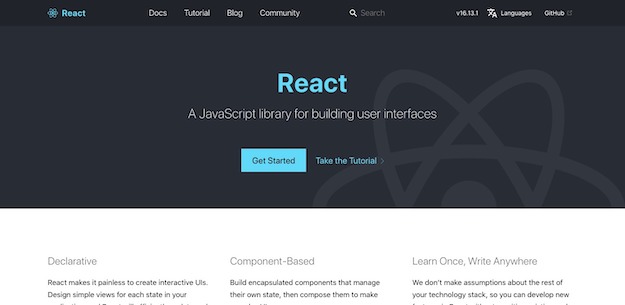Today, the world cannot exist without mobile and online applications. Everything has been digital, from taxi reservations to restaurant ordering to banking transactions. Due to the effective frameworks that ensure a consistent user experience. React is one such strong frontend library. This beginners guide on react basics will walk you through the principles of the framework and demonstrate how it works with a simple example.
What is React?

React was created by Facebook in 2011 and has swiftly grown to be one of the most popular JavaScript libraries. According to HackerRank, 30% of organizations want engineers who are familiar with React, while only approximately half of candidates possess the necessary knowledge.
Clearly, there is a significant need for React developers in the employment market.
Beyond the User interfaces, A Beginner’s Guide On React Basics, extensions and class components that provide support for the complete application architecture, such as Flux and React Native.
Why React?
Today, the popularity of react js has surpassed all other front-end development frameworks. Here are the reasons:
Easy production of dynamic online apps: React component simplifies the process of developing dynamic web applications by requiring less coding and providing more functionality, in comparison to JavaScript, where writing frequently becomes highly difficult very rapidly.
Improved performance: React makes advantage of Virtual DOM, which speeds up the creation of web apps. Instead of updating all components again, the Virtual DOM examines their past states and updates just the objects in the Real DOM that have changed, as typical web applications do.
Components are the fundamental building elements of any React application, and a single application is often composed of numerous components. These components include logic and controls that may be reused across the programme, significantly reducing development time.
React’s data flow is unidirectional. This implies that developers frequently layer child components within parent components when developing a React application. Because data travels in a single path, debugging issues and determining where a problem arises in an application becomes easy.
React has a low learning curve since it mixes core HTML and JavaScript ideas with some advantageous improvements. Nonetheless, like with other tools and frameworks, it takes time to gain a thorough grasp of React’s library.
It may be used to construct both online and mobile applications: While we already know that React is used to construct online apps, that is not all it is capable of. There is a framework called React Native that is quite popular and is used to create stunning mobile applications. It is developed from React itself. Thus, React may be used to create online and mobile applications.
Dedicated debugging tools: Facebook has created a Chrome plugin for debugging React apps. This speeds up and simplifies the process of debugging React web apps.
The arguments outlined above more than support the React library’s success and widespread use by organizations and corporations. Now, let’s become acquainted with React’s features.
Don’t Miss-
Reactjs Vs React Native : What’s the Difference? Which One is Better?
8 Performance Tips for React Native Application Development
Features of React
React has a number of distinguishing characteristics that contribute to its popularity as the most extensively used library for frontend application development. The following is a list of those distinguishing features that can be experienced in any react app building user interfaces.
1. JSX
JSX is a syntactic extension for JavaScript. It’s a phrase used in React to define the appearance of any simple or complex user interface. By leveraging JSX, you may write HTML structures alongside JavaScript code in the same file.
The preceding code demonstrates how React implements JSX. This is neither a string nor an HTML document. Rather than that, it embeds HTML into JavaScript code.
2. Virtual Document Object Model (DOM)
React’s Virtual DOM is a lightweight implementation of the Real DOM. Manipulation of the real DOM is significantly slower than manipulation of the virtual DOM. When the state of an item changes, Virtual DOM updates only that object in the real DOM, rather than the entire collection.
3. What is the Document Object Model (DOM)?
The DOM model represents an XML or HTML content as a tree structure with each node representing an object representing a component of the document.
How do the Virtual DOM and React DOM Interact?
When an object’s state changes in a React application, the VDOM is updated. It then compares its current state to its prior state and updates only those items in the real DOM, rather than updating all objects. This speeds up the process, particularly when compared to other front-end technologies, which must update each object even if just a single item in the web application changes.
1. Architecture
React is the ‘View’ in a Model View Controller (MVC) architecture, responsible for the app’s appearance and feel.
MVC is a design pattern that divides the application layer into three components: Model, View, and Controller. The model contains all data-related logic; the view contains the application’s user interface logic, and the controller serves as an interface between the Model and View.
2. Extensions
React is more than simply a UI framework; it has several extensions that span the entirety of an application’s architecture. It facilitates the development of mobile applications and enables server-side rendering. Among other things, Flux and Redux may be used to augment React.
3. Data Binding
Due to React’s one-way data binding, all actions remain modular and performant. Additionally, because of the unidirectional data flow, it is typical for child components to be nested within parent components while designing a React project.
4. Debugging
Due to the existence of a large developer community, React apps are simple to design and test. Facebook offers a browser plugin that simplifies and accelerates the debugging process for React.
For instance, this extension adds a React tab to the developer tools menu in Chrome. The tab enables direct inspection of React components.
Conclusion
So, this was the beginners guide on React basics, I hope the guide on “What is React” helped you have a basic understanding of how React works. A full-stack development course is beneficial if you’re interested in learning React and becoming a frontend developer. You can also opt for online tutorials that are reliable with true information.

